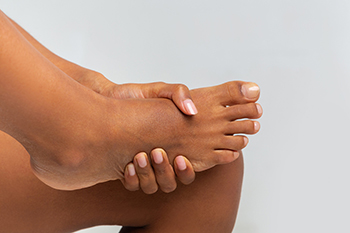
Foot pain can come from many sources, but simple steps often make a difference. Sore heels are frequently caused by plantar fasciitis, which may improve with calf stretching, wearing supportive shoes, and massage. Bunions, a misalignment of the big toe joint, can be eased by wearing wide shoes, using protective padding, or custom orthotics to reduce pressure. Ball of foot pain, often linked to metatarsalgia, may respond to cushioned insoles and activity modification. For toe deformities such as hammertoes, gentle stretching and shoes with extra depth can help reduce irritation. While these measures often bring relief, lingering pain should not be ignored, as untreated problems may worsen over time. If you continue to struggle with foot discomfort, it is suggested that you schedule a visit with a podiatrist for an accurate diagnosis and effective treatment plan.
Foot Pain
Foot pain can be extremely painful and debilitating. If you have a foot pain, consult with Arnold Farbstein, DPM from Texas. Our doctor will assess your condition and provide you with quality foot and ankle treatment.
Causes
Foot pain is a very broad condition that could be caused by one or more ailments. The most common include:
- Bunions
- Hammertoes
- Plantar Fasciitis
- Bone Spurs
- Corns
- Tarsal Tunnel Syndrome
- Ingrown Toenails
- Arthritis (such as Gout, Rheumatoid, and Osteoarthritis)
- Flat Feet
- Injury (from stress fractures, broken toe, foot, ankle, Achilles tendon ruptures, and sprains)
- And more
Diagnosis
To figure out the cause of foot pain, podiatrists utilize several different methods. This can range from simple visual inspections and sensation tests to X-rays and MRI scans. Prior medical history, family medical history, and any recent physical traumatic events will all be taken into consideration for a proper diagnosis.
Treatment
Treatment depends upon the cause of the foot pain. Whether it is resting, staying off the foot, or having surgery; podiatrists have a number of treatment options available for foot pain.
If you have any questions, please feel free to contact our office located in Houston, TX . We offer the newest diagnostic and treatment technologies for all your foot care needs.

Zumba is a lively and enjoyable way to stay active, but its fast movements and repetitive steps can sometimes lead to musculoskeletal injuries. The feet and ankles are especially at risk since they absorb the impact of jumps, pivots, and quick turns. Common injuries include sprained ankles, heel pain from plantar fasciitis, and stress on the Achilles tendon. The knees may also be affected when improper shoes or surfaces are used. Wearing supportive footwear designed for dance or cross training can reduce the risk of injury by providing stability and cushioning. Warming up before class and incorporating stretching exercises afterward are equally important. Listening to your body and pacing yourself can help prevent overuse. If you develop foot or ankle pain or swelling during Zumba, it is suggested that you schedule an appointment with a podiatrist for a proper evaluation and appropriate care.
Ankle and foot injuries are common among athletes and in many sports. They can be caused by several problems and may be potentially serious. If you are feeling pain or think you were injured in a sporting event or when exercising, consult with Arnold Farbstein, DPM from Texas. Our doctor will assess your condition and provide you with quality foot and ankle treatment.
Common Injuries
The most common injuries that occur in sporting activities include:
- Achilles Tendonitis
- Achilles Tendon Rupture
- Ankle Sprains
- Broken Foot
- Plantar Fasciitis
- Stress Fractures
- Turf Toe
Symptoms
Symptoms vary depending upon the injury and in some cases, there may be no symptoms at all. However, in most cases, some form of symptom is experienced. Pain, aching, burning, bruising, tenderness, tightness or stiffness, sensation loss, difficulty moving, and swelling are the most common symptoms.
Treatment
Just as symptoms vary depending upon the injury, so do treatment options. A common treatment method is known as the RICE method. This method involves rest, applying ice, compression and elevating the afflicted foot or ankle. If the injury appears to be more serious, surgery might be required, such as arthroscopic or reconstructive surgery. Lastly, rehabilitation or therapy might be needed to gain full functionality in the afflicted area. Any discomfort experienced by an athlete must be evaluated by a licensed, reputable medical professional.
If you have any questions please contact our office located in Houston, TX . We offer the newest diagnostic and treatment technologies for all your foot and ankle needs.
 Many people have a difficult time recovering from falls that have occurred. Their feet may have become affected, and it may be overwhelming to complete daily activities. There are specific methods that can be implemented that may help to reduce the risk of falling. These can include removing worn rugs from the living environment, installing grab bars in the shower and toilet areas, and it may help to improve existing lighting. Additionally, it is beneficial to have current medication checked by having routine physical and eye examinations performed. Many patients find they may fall less often when the proper shoes are worn. If you would like more information about how possible foot conditions may be avoided by using fall prevention techniques, please confer with a podiatrist.
Many people have a difficult time recovering from falls that have occurred. Their feet may have become affected, and it may be overwhelming to complete daily activities. There are specific methods that can be implemented that may help to reduce the risk of falling. These can include removing worn rugs from the living environment, installing grab bars in the shower and toilet areas, and it may help to improve existing lighting. Additionally, it is beneficial to have current medication checked by having routine physical and eye examinations performed. Many patients find they may fall less often when the proper shoes are worn. If you would like more information about how possible foot conditions may be avoided by using fall prevention techniques, please confer with a podiatrist.
Preventing falls among the elderly is very important. If you are older and have fallen or fear that you are prone to falling, consult with Arnold Farbstein, DPM from Texas. Our doctor will assess your condition and provide you with quality advice and care.
Every 11 seconds, an elderly American is being treated in an emergency room for a fall related injury. Falls are the leading cause of head and hip injuries for those 65 and older. Due to decreases in strength, balance, senses, and lack of awareness, elderly persons are very susceptible to falling. Thankfully, there are a number of things older persons can do to prevent falls.
How to Prevent Falls
Some effective methods that older persons can do to prevent falls include:
- Enrolling in strength and balance exercise program to increase balance and strength
- Periodically having your sight and hearing checked
- Discuss any medications you have with a doctor to see if it increases the risk of falling
- Clearing the house of falling hazards and installing devices like grab bars and railings
- Utilizing a walker or cane
- Wearing shoes that provide good support and cushioning
- Talking to family members about falling and increasing awareness
Falling can be a traumatic and embarrassing experience for elderly persons; this can make them less willing to leave the house, and less willing to talk to someone about their fears of falling. Doing such things, however, will increase the likelihood of tripping or losing one’s balance. Knowing the causes of falling and how to prevent them is the best way to mitigate the risk of serious injury.
If you have any questions, please feel free to contact our office located in Houston, TX . We offer the newest diagnostic and treatment technologies for all your foot care needs.

